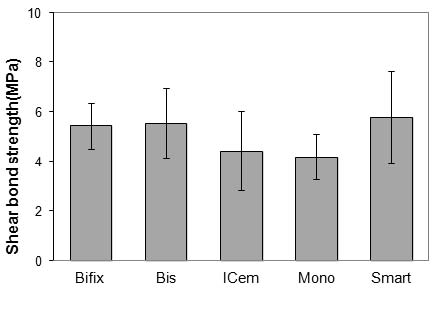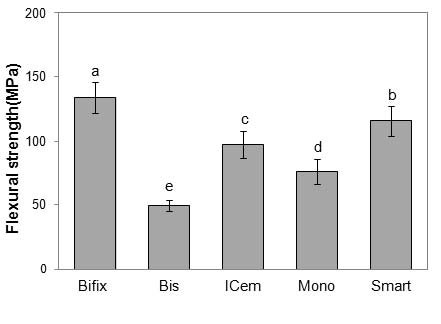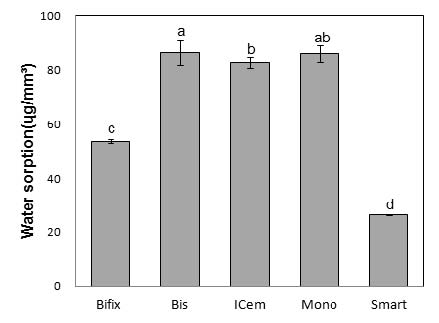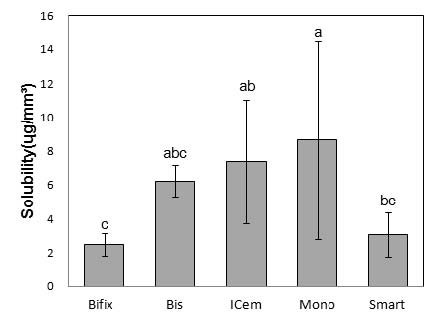
Shear bond strength, flexural strength, water sorption and solubility of self-adhesive resin cement
The use of self-adhesive resin cement is being increased due to its convenience. The purpose of this study was to compare the shear bond strength, flexural strength, water sorption and solubility of various self-adhesive resin cements. Self-adhesive resin cement used in the experiment was Bifix SE(Bifix), Bis Cem(Bis), ICem(ICem), MonoCem(Mono) and SmartCem(Smart). In order to measure the shear bond strength, bovine teeth was embedded in acrylic resin and ground until superficial dentin was exposed. Blocks using composite resin were produced(2.3 mm in diameter × 2.2 mm in height) and they were applied on bovine teeth with resin cement according to the manufacture's instructions. Adhered sample were kept in 37℃ distilled water for 24 hours before experiment was done, the shear bond strength was measured by using a universal testing machine(Z020, Zwick, Ulm, Germany) with cross-head speed of 0.75 mm/min. Specimens for the flexural strength was tested with the same cross-head speed. Then, water sorption and solubility were measured. The shear bond strength of self-adhesive resin cement were no significantly differences(p>0.05). In flexural strength, the Bifix SE(Bifix) was significantly higher than other groups, then there was SmartCem(Smart)(p<0.05). In water sorption, the SmartCem(Smart) was significantly lower than other groups, then there was Bifix SE (Bifix)(p<0.05). BisCem(Bis) was significantly higher than other groups(p<0.05), and the MonoCem(Mono) was not significant difference (p>0.05). In solubility, the Bifix SE(Bifix) was lowest rate(p<0.05), and Smart Cem(Smart) and BisCem (Bis) were no significant differences(p>0.05). In this study, Smart Cem(Smart) and Bifix SE(Bifix) high flexural strength, low water sorption and solubility, so is a clinically favorable self-adhesive resin cement.
Keywords:
Self-adhesive resin cement, Shear bond strength, Flexural strength, Water sorption, Solubility서 론
치과용 시멘트는 치아에 수복물이나 교정 장치를 합착하거나 치수를 보호하고 수복물의 하부구조를 만들기 위한 와동 이장재 및 베이스, 충전재의 용도로 다양하게 사용된다. 수복물의 합착에 사용되는 시멘트는 구강 내에서 용해도가 낮아야 하며, 치아 또는 수복물과 높은 결합력을 보여야 한다. 또한 수복물과 치아 사이의 계면에서 응력에 저항할 수 있는 강도를 가져야하며, 사용이 편리하고 생체 적합성이 있어야 한다(Smith, 1968). 치과계에서 사용되고 있는 시멘트는 water-based, oil-based, 레진 제재(resin-based) 시멘트로 나뉜다(Edelhoff와 Ozcan, 2007). Oil-based 시멘트는 zinc oxide-eugenol과 zinc oxide-non-eugenol로 분류되고(Kramer 등, 2000; Burke, 2005), water-based 시멘트는 글라스아이오노머, zinc phosphate와 resin modified glass-ionomer(RMGI) 시멘트로 분류된다. 그리고 레진 제재 시멘트는 conventional resin 시멘트, adhesive resin 시멘트와 자가 접착 레진(selfadhesive resin)시멘트로 분류된다. Water-based 시멘트의 글라스아이오노머 시멘트의 경우 상아질에 대한 결합강도를 증진시키지 않는다고 보고되고 있다(Hinoura, 1991). 이러한 단점을 극복하기 위해 RMGI 시멘트가 개발되었으나 레진 제재 시멘트에 비해 물리적 성질, 표면 활택도 및 투명도가 떨어져 비심미적이며, 광중합 과정에서도 중합되지 않은 monomer가 발생되어 치수독성이 나타나는 단점이 있다(Wilson, 1990).
이에 따라 최근에는 심미적이면서 물리적 성질이 우수한 레진 제재 시멘트의 사용이 급증하고 있는 추세이다(Attar 등, 2003). Conventional resin 시멘트는 레진 시멘트 자체에 접착성분이 들어 있지 않기 때문에 산부식 및 primer 도포와 adhesive 도포 과정이 필요하다. 이러한 방법은 술식에 민감하여 방습 및 상아질의 젖음성을 적절히 유지하지 못할 경우 치아와의 결합강도가 감소할 수 있다 (Frankenberger 등, 2000). 이러한 전처리과정을 간소화하고 산부식된 상아질의 콜라겐 섬유의 붕괴를 막기 위해 adhesive resin 시멘트가 개발되었다. 이는 4-META, 10-MDP 또는 Phenyl P와 같이 상아질과 합착을 위해 화학적으로 반응하는 단량체를 포함하고 있지만 따로 primer를 처리하는 과정이 필요하며, 기존의 시멘트에 비해 결합력이 낮은 것으로 알려져 있다(Knobloch 등, 2007; Li 등 2010; Ozcan와 Mese 2012).
이러한 문제점을 보완하기 위해 최근에는 치아의 전처리과정이 생략된 자가 접착 레진 시멘트가 개발되었다. 자가 접착 레진 시멘트는 도재와 금속 등 광범위한 수복물의 접착에 사용이 가능하며, 그 성분은 산성의 기능성 단량체와 염기성 충진재로 구성된다. 산성의 단량체는 치아를 부식시킴과 동시에 치질로 침투하여 미세한 기계적 유지력을 얻으며, 염기성의 충진재 및 치아의 수산화인회석과 산 염기 반응을 하여 산도를 중화하고 치아와 화학적 결합을 이룬다. 경화반응은 자유라디칼중합에 의해 이루어지며 빛이나 산화환원반응에 의해 중합이 개시된다고 보고되고 있다(Behr 등, 2004; Cobb 등, 2004).
최근 새로 소개된 자가 접착 레진 시멘트와 치아와의 전단결합강도나 레진, 금속, 세라믹과 같은 재료와의 전단결합강도에 관한 연구들이 활발히 이루어지고 있지만, 시편의 단면적이나 지그의 날 형태, cross-head speed에 따른 실험조건에 따라 결과가 다르게 나타났으며, 기존연구에서는 국제표준이 없어 다양한 방법으로 실험된 결과를 비교할 수 없었다. ISO/TC106/ SC1/WG15에서 자가 접착 레진 시멘트의 규격을 제정 중에 있는데(ISO/WD 16506 #3.5), 이 방법은 기존연구와 비교해 보면 지그의 날이 반원형으로 기존연구의 일자형에 비해 날이 피착재를 에워싸게 되어 전단결합강도 측정 시 측정값이 더 낮게 나오게 되지만 비교적 정확하고 표준화된 방법으로 연구자간 연구결과의 비교가 가능하게 될 것이다.
평상시 음식을 저작 할 때 치아에 반복적인 하중이 발생하는데 합착용 시멘트의 기계적인 유지력 실패에 중요하게 작용된다. 그러므로 레진 제재의 시멘트의 굴곡강도는 파절과 영구변형 없이 스트레스에 저항하는 중요한 능력이다(Saskalauskaite와 Tam, 2008). 물 흡수도는 충진재-레진 기질 계면의 약화와 가소제의 작용으로 기계적, 물리적으로 악화되는 결과를 보여준다(Diaz-Arnold 등, 1992). 게다가 물 흡수도는 재료의 변색을 일으켜, 수복 후 심미적인 결과를 기대하기 어렵다. 물의 작용은 시멘트의 물리적 성질을 저하 시키는 과정에 중요한 역할을 하며(Ruyter, 1995), formaldehyde와 methacrylic acid와 같은 화학적 물질의 독성을 이끌어낸다(Oysaed 등, 1988; Munksgaard와 Freund, 1990). 위와 같은 방출은 이러한 재료의 구강내의 생체적합성에 부합하지 않으며, 연조직 주변의 잠재적인 위험 요소로 작용한다(Mac Dougall 등, 1997; Soderholm와 Mariotti, 1999).
이에 본 연구는 자가 접착 레진 시멘트의 전단결합강도뿐만 아니라 시멘트의 중요한 물성인 굴곡강도, 물 흡수도, 용해도를 비교 평가함으로써 시멘트의 기계적, 화학적 물성이 우수한 자가 접착 레진 시멘트를 찾아 임상적인 지침을 삼고자 하는데 목적이 있다.
재료 및 방법
1. 실험 재료
본 연구에는 5가지 자가 접착 레진 시멘트가 실험에 사용되었으며, dual-cure type이었다(Table 1). 모든 실험에서 시멘트별로 5개의 시편을 제작하였다.
발거 후 3일 이내의 bovine incisor를 증류수에 넣어 4°C에서 냉장 보관하여 사용하였으며, 실험에 사용된 피착재를 제작하기 위해 수복용 복합레진 CLEARFIL AP-X (Kuraray MEDICAL Inc., Kurashiki, Japan)를 이용하였다.
2. 전단결합강도
전단결합강도 측정을 위한 피착재를 제작하기 위하여 ISO/WD 16506 # 3.5 Dentistry - Polymer-based luting materials containing adhesive components (ISO 4049)에 따라 직경 2.3 mm × 높이 2.2 mm의 원통형의 composite resin block을 제작하였다(Figure 1).
최근 6개월 내에 발거된 25개의 우식이 없는 bovine incisor를 백악법랑경계에서 치근부분은 절단하고 치관부분을 사용하였으며 치수를 제거하고 utility wax로 매립하였다. Bovine teeth를 원통형 테플론 몰드에 교정용 아크릴릭 레진(Ortho-Jet, Lang Dental Manufacturing co., Wheeling, USA)으로 포매하고, abrasive paper 120번, 400번을 사용하여 superficial dentin이 노출될 때까지 연마하였다.
포매한 25개의 치아시편은 5가지 자가 접착 레진 시멘트의 종류에 따라 실험군을 5개씩 분류하였다. 접착 전에 치면을 10초간 수세 후 건조 하였으며 composite resin block에 CLEARFIL CERAMIC PRIMER(Kuraray MEDICAL Inc., kurashiki, Japan)를 5초간 적용 후 건조하였다. 건조한 면에 5가지 자가 접착 레진 시멘트를 각각 도포하여 치면에 접착한 후 제조사의 지시에 따라 면당 20초씩 광중합 하였다. 접착된 시편은 시험 전까지 37°C 증류수에 24시간 동안 보관하였다. 전단결합강도는 만능시험기(Z020, Zwick, Ulm, Germany)를 이용하여 0.75 mm/min cross-head speed로 측정하였으며 사용된 지그는 Figure 2와 같다.
3. 굴곡강도
굴곡강도 시편을 제작하기 위하여 길이 25 mm × 직경 2.0 mm × 높이 2.0 mm의 몰드를 준비하였다. 각 유리판 위에 몰드를 올려놓고 자가 접착 레진 시멘트를 주입하고 OHP필름으로 덮고 유리판을 덮어 1분간 1 kg의 압력으로 하중을 가한 후, overlapping 하여 광중합을 하였다. 광중합 후 37°C water bath 안에 15분간 유지하고 320번 abrasive paper로 연마 한 후 조심스럽게 몰드에서 시편을 제거한 다음 혼합 한 시점부터 24시간 동안 37°C 증류수에 보관하였다. 굴곡강도의 측정을 위하여 만능시험기(Z020, Zwick, Ulm, Germany)를 이용하여 측정하였고 만능시험기 내의 프로그램(TestXpert 11.0, Zwick, Ulm, Germany)에 의해 계산되었으며, cross-head speed는 0.75 mm/min이었다. 굴곡강도(σ)의 계산식은 국제표준 ISO/WD 16506 #3.5에 따라 다음과 같다.
4. 물 흡수도, 용해도
물 흡수도를 측정하기 위해 직경 15.0 mm × 높이 1.0 mm의 몰드에 각각의 시멘트를 주입하고 각 제조사의 지시에 따라 광중합을 하였다. 제작된 시편을 37°C dry oven에서 22시간 보관하고 silica gel이 있는 23°C 실온의 desiccator에 옮겨 2시간 동안 유지 후 24시간 간격으로 측정하여 0.1 mg 이내의 오차가 발생될 때의 시편무게를 m₁이라 측정하고, 이때 시편의 중앙에서 두께를 측정하고 시편 둘레 4부위에서 동등한 지점의 직경을 측정하여 평균을 구하고 부피를 측정하였다. 그 후, 37°C 물속에서 7일간 보관 후 물기를 제거하고 1분 후 측정한 무게를 m₂라고 하였다. 24시간 주기로 37°C dry oven에서 22시간, 23°C 실온의 desiccator에서 2시간으로 유지 후 측정된 무게가 0.1 mg 이내의 오차가 발생될 때의 무게를 m₃로 측정하였다. m₂에서 m₃무게 값을 뺀 값을 시편의 부피 값으로 나누어 물 흡수도를 측정하였고, m₁에서 m₃무게 값을 뺀 값을 시편의 부피 값으로 나누어 용해도를 측정하였다.
5. 통계분석
통계분석은 SPSS 프로그램(SPSS 12.0; SPSS GmbH, Munich, Germany)을 이용하였다. 모든 실험군의 전단결합강도, 굴곡강도, 물 흡수도, 용해도를 one-way ANOVA로 신뢰수준 95%에서 분석하였고, 사후검정으로 Duncanʹs multiple range test를 시행하였다. 전단결합강도와 굴곡강도 및 물 흡수도와 용해도와의 관련성은 Pearson의 상관관계를 이용하였다.
결 과
1. 전단결합강도
자가 접착 레진 시멘트의 전단결합강도는 Figure 3과 같다. 실험군 간의 전단결합강도는 모두 유의한 차이를 나타내지 않았다(p>0.05).
2. 굴곡강도
자가 접착 레진 시멘트의 굴곡강도는 Figure 4와 같다. Bifix가 나머지 실험군보다 유의성 있게 높게 나타났고 Smart가 그다음으로 높았다(p<0.05).
3. 물 흡수도
자가 접착 레진 시멘트의 물 흡수도는 Figure 5에 나타나 있다. Smart는 다른 실험군에 비해 유의성 있게 가장 낮은 물 흡수도를 보였고 Bifix가 그 다음으로 낮았다(p<0.05). Bis는 다른 실험군에 비해 유의성 있게 높았고(p<0.05), Mono와는 유의성 있는 차이가 없었다(p>0.05).
4. 용해도
자가 접착 레진 시멘트의 용해도는 Figure 6에 나타나 있다. Bifix가 다른 실험군에 비해 가장 낮았고(p<0.05), Smart와 Bis와는 유의한 차이가 없었다(p>0.05).
5. 전단결합강도, 굴곡강도, 물 흡수도와 용해도와의 상관관계
자가 접착 레진 시멘트의 전단결합강도, 굴곡강도, 물 흡수도와 용해도와의 상관관계는 Table 2에 나타나 있다. 물 흡수도는 전단결합강도(r=-0.319)와 굴곡강도(r=-0.583)에서 음의 상관관계가 나타났다. 용해도는 전단결합강도(r=-0.369), 굴곡강도와 음의 상관관계가 나타났다(r=-0.398). 그러나 물 흡수도는 양의 상관관계가 나타났다(r=0.540). 전단결합강도와 굴곡강도, 물 흡수도 및 용해도와는 큰 상관관계가 나타나지 않았다.
고 찰
본 연구에서는 자가 접착 레진 시멘트간의 전단결합강도, 굴곡강도, 물 흡수도, 용해도를 비교 평가하고자 하였다.
자가 접착 레진 시멘트의 전단결합강도는 실험군 모두에서 유의한 차이를 나타내지 않았다. Piwowarczyk 등(2004)과 Thomas 등(2012)의 연구와 비교해 볼 때, conventional resin 시멘트 보다 낮은 전단결합강도를 보이고 있는데 이는 shear loading 지그의 날이 이전 연구에서는 무딘 치질형태인 것에 비해 본 연구에서는 반원형의 예리한 날을 사용한 데 일부 원인이 있는 것으로 사료된다. 그러나 본 연구에서의 접착 부위의 단면적이 두 연구에 비해 상대적으로 작고 만능시험기의 crosshead speed가 다르므로 측정한 결합강도치의 정확한 비교분석에는 어려움이 있을 수 있다. 그러나 예비실험을 통해 RelyX Unicem2 Automix(3M ESPE, Paul, USA)로 전단결합강도를 측정 하였을 때 (16.37 ± 0.15) MPa가 나와 다른 실험 조건임에도 불구하고 Piwowarczyk 등(2004)과 Thomas 등(2012)의 연구에서conventional resin 시멘트와 비슷한 수준의 높은 전단결합강도를 보였다. 그 원인으로 conventional resin 시멘트 같은 경우, 산부식 과정을 거치고 수세를 하면 도말층이 제거되고 상아세관과 상아세관 사이의 관간 상아질 표면의 무기질이 일부 빠져나가면서 3차원적인 콜라겐 네트워크가 노출되고 상아세관의 입구가 확장된다(Perdigão 등, 1996). 이에 primer를 도포하면 콜라겐 네트워크 사이로 primer가 물을 치환하며 스며들고, 이 후 소수성의 adhesive agent를 도포하면 primer를 따라 adhesive resin monomer가 침투하면서 상아질과 레진 시멘트 사이에 혼성층이 형성된다(Pashley와 Carvalho, 1997). 이에 따라 상아질 접착제를 사용하는 conventional resin 시멘트의 접착면에서 콜라겐 섬유와 adhesive resin monomer가 혼재되어 있는 혼성층과 상아세관 내에 resin tag가 관찰되어(De Munck 등, 2004; Yang 등, 2005), 기계적 결합과 화학적 결합력이 복합적으로 작용하게 된다(Vargas MA 등, 1997).
그러나 자가 접착 레진 시멘트의 경우 전처리 과정이 생략되면서 시멘트 적용시 도말층이 그대로 남아 있게 된다. 자가 접착 레진 시멘트의 구성성분 중 phosphoric acid methacrylates는 최소 두 개의 탄소 이중결합을 가져 도말층과 하부의 상아질을 탈회시키고, 흡수성의 상아질 표면에 스며든다. 선행 연구에 의하면 접착면의 초기경화 시 낮은 산도를 나타내지만 탈회의 흔적과 혼성층이나 레진 tag없이 하부 상아질과 표면적으로 서로 작용함이 관찰되었다고 보고된 바 있다(Hasegawa 등, 1991; De Munck 등, 2004). 또한 phosphoric acid methacrylates는 수소결합으로 인해 물리적인 유지력이 다른 시멘트와 비교했을 때 강하다고 보고된 바 있다. 이에 따라, phosphoric acid methacrylates는 시멘트의 결합강도에 영향을 미치는 요인이며, 제품자체가 함유하고 있는 성분들의 조합이 다른 자가 접착 레진 시멘트에 비해 산성이 중화되는 속도가 월등히 빠르다는 점과 함유 되어있는 phosphoric acid methacrylates와 silanated alkaline filler와 치아의 hydroxyapatite가 중화반응을 하여 생성된 물로 인해 wettability가 좋아진 점이 결합강도를 높이는데 기여했다고 보고되고 있다(Piwowarczyk 등, 2004; Bitter 등, 2006).
자가 접착 레진 시멘트의 굴곡강도는 Bifix가 다른 실험군에 비해 유의하게 높게 나타났으며, 그다음으로는 Smart가 높게 나타났다. Duymus 등(2013)의 연구에서의 conventional resin 시멘트와 본 연구에서의 자가 접착 레진 시멘트의 굴곡강도를 비교해 보았을 때, conventional resin 시멘트인 Panavia F보다 Bifix와 Smart는 더 높은 굴곡강도를 나타내고 있다. 나머지 자가 접착 레진 시멘트의 경우 conventional resin 시멘트보다 비슷하거나 약간 낮은 수준을 나타내고 있어 굴곡강도는 conventional resin 시멘트와 비교 한 결과 뒤떨어지지 않음을 알 수 있다. 자가 접착 레진 시멘트의 물 흡수도는 Smart가 다른 실험군에 비해 가장 낮게 나타났으며, 그 다음으로 Bifix가 낮게 나타났다. Vrochari 등(2010)의 연구에서와 마찬가지로 Bis가 물 흡수도가 높게 나타나 비슷한 결과를 보이고 있다. 자가 접착 레진 시멘트의 용해도는 Bifix와 Smart가 낮게나와 우수한 물성을 보여주고 있다.
본 연구를 통해서 자가 접착 레진 시멘트의 전단결합강도와 굴곡강도, 물 흡수도 및 용해도를 확인한 결과 전단결합강도에서는 차이가 없지만 굴곡강도가 유의성 있게 높고, 물 흡수도와 용해도가 낮은 Bifix와 Smart가 우수한 자가 접착 레진 시멘트로 사료된다. 아직 자가 접착 레진 시멘트의 물성과 관련된 연구가 많이 진행되고 있지 않아 계속적인 연구가 필요하지만 전처리 과정이 간단하면서도 기계적. 화학적 물성 및 결합강도가 우수하다면 임상적으로 매우 유용하게 사용 될 것으로 사료된다.
결 론
자가 접착 레진 시멘트의 전단결합강도뿐만 아니라 시멘트의 중요한 물성인 굴곡강도, 물 흡수도, 용해도를 비교 평가한 결과 다음과 같은 결론을 얻었다.
1. 전단결합강도는 실험군 간의 유의성 있는 차이가 없었다(p>0.05).
2. 굴곡강도는 Bifix가 유의성 있게 높게 나타났으며, Smart가 그 다음으로 높았다(p<0.05).
3. 물 흡수도는 Smart가 다른 실험군에 비해 가장 유의성 있게 낮았으며, Bifix가 그 다음으로 낮았다(p<0.05).
4. 용해도는 Bifix가 다른 실험군에 비하여 유의성 있게 낮았으나 Smart와 Bis와는 유의한 차이가 없었다(p>0.05).
본 연구를 통해 자가 접착 레진 시멘트의 전단결합강도는 모두 유의성 있는 차이를 나타내지 않았다. Bifix와 Smart는 굴곡강도가 유의성 있게 높고 용해도와 물 흡수도가 낮아 임상에 유리한 자가 접착 레진 시멘트로 사료된다.
Acknowledgments
이 논문은 2012년 기술표준원 국가표준기술력향상사업 (10042376)의 결과임
References
-
N Attar, LE Tam, D McComb, Mechanical and physical properties of contemporary dental luting agents, J Prosthet Dent, (2003), 89, p127-134.
[https://doi.org/10.1067/mpr.2003.20]

- M Behr, M Rosentritt, T Regnet, R Lang, G Handle, Marginal adaptation in dentin of a selfadhesive universal resin cement compared with well-tried systems, Dent Mater J, (2004), 20, p191-197.
-
K Bitter, H Meyer-Lueckel, K Priehn, JP Kanjuparambil, K Neumann, AM Kielbassa, Effects of luting agent and thermocycling on bond strengths to root canal dentine, Int Endod J, (2006), 39, p809-18.
[https://doi.org/10.1111/j.1365-2591.2006.01155.x]

- FJ Burke, Trends in indirect dentistry: 3, Luting materials. Dent Update, (2005), 32, p251-254-257-258, 260.
- D Cobb, Timmons, C Stanford, D Dawson, G Denehy, M Vargas, Clinical outcomes of ceramic inlays/ onlays luted with two bonding systems, J Dent Res, (2004), 83, p1539.
- J De Munck, M Vargas, K Van Landuyt, K Hikita, P Lambrechts, B VanMeerbeek, Bonding of an auto-adhesive luting material to enamel and dentin, Dent Mater J, (2004), 20, p963-971.
- AM Diaz-Arnold, MA Arnold, VD Williams, Measurement of water sorp tion by resin composite adhesives with Near-Infrared Spectroscopy, J Dent Res, (1992), 71, p438-442.
-
ZY Duymus, ND Yanikoğlu, M Alkurt, Evaluation of the flexural strength of dual-cure composite resin cements, J Biomed Mater Res B Appl Biomater, (2013), 29, p1-4.
[https://doi.org/10.1002/jbm.b.32892]

-
D Edelhoff, M Ozcan, To what extent does the longevity of fixed dental prostheses depend on the function of the cement? Working group 4 materials: cementation, Clin Oral Implants Res, (2007), 18, p193-204.
[https://doi.org/10.1111/j.1600-0501.2007.01442.x]

- R Frankenberger, N Kramer, A Petschelt, Technique sensitivity of dentin bonding: effect of application mistakes on bond strength and marginal adaptation, Oper Dent, (2000), 25, p324-330.
-
EA Hasegawa, DB Boyer, DC Chan, Hardening of dual-cured cements under composite resin inlays, J Prosthet Dent, (1991), 66, p187-192.
[https://doi.org/10.1016/S0022-3913(05)80046-0]

-
K Hinoura, M Miyazaki, H Onose, Dentin bond strength of light-cured glass-ionomer cements, J Dent Res, (1991), 70, p1542-1544.
[https://doi.org/10.1177/00220345910700121301]

- T Hitz, B Stawarczyk, J Fischer, CH Hämmerle, I Sailer, Sailer Are self -adhesive resin cements a valid alternative to conventional resin cements? A laboratory study of the long-term bond strength, Dent Mater, (2012), 28, p1183-1190.
- International Organization for standardization, ISO/WD 16506. Dentistry - Polymer-based luting materials containing adhesive components, Geneva: Switzerland, ISO, (2012).
-
LA Knobloch, D Gailey, S Azer, WM Johnston, N Clelland, RE Kerby, Bond strengths of one- and two-step self-etch adhesive systems, J Prosthet Dent, (2007), 97, p216-222.
[https://doi.org/10.1016/j.prosdent.2007.02.013]

- N Kramer, U Lohbauer, R Frankenberger, Adhesive luting of indirect restorations, Am J Dent, (2000), 13, p60-76.
-
N Li, T Nikaido, T Takagaki, A Sadr, P Makishi, J Chen, J Tagami, The role of functional monomers in bonding to enamel: acid-base resistant zone and bonding performance, J Dent, (2010), 38, p722-30.
[https://doi.org/10.1016/j.jdent.2010.05.015]

- M Mac Dougall, JK Selden, JR Nydegger, DL Carnes, Immortalized mou se odontoblast cell line M06-G3 application for in vitro biocompatibility testing, Am J Dent, (1997), 11, p11-16.
-
EC Munksgaard, M Freund, Enzymatic hydrolysis of (di)methacrylates and their polymers, Scand J Dent Res, (1990), 98, p261-267.
[https://doi.org/10.1111/j.1600-0722.1990.tb00971.x]

-
H Oysaed, IE Ruyter, IJ Sjovic Kleven, Release of formaldehyde from dental composites, J Dent Res, (1988), 67, p1289-1294.
[https://doi.org/10.1177/00220345880670100901]

- M Ozcan, A Mese, Adhesion of conventional and simplified resin-based luting cements to superficial and deep dentin, Clin Oral Investig, (2012), 16, p1081-1088.
-
DH Pashley, RM Carvalho, Dentine permeability and dentine adhesion, J Dent, (1997), 25, p355-372.
[https://doi.org/10.1016/S0300-5712(96)00057-7]

-
J Perdigão, P Lambrechts, B van Meerbeek, AR Tomé, G Vanherle, AB Lopes, Morphological field emission-SEM study of the effect of six phosphoric acid etching agents on human dentin, Dent Mater, (1996), 12, p262-271.
[https://doi.org/10.1016/S0109-5641(96)80033-9]

-
A Piwowarczyk, HC Lauer, JA Sorensen, In vitro shear bond strength of cementing agents to fixed prosthodontic restorative materials, J Prosthet Dent, (2004), 92, p265-273.
[https://doi.org/10.1016/j.prosdent.2004.06.027]

-
IE Ruyter, Physical and chemical aspects related to substances released from polymer materials in an aqueous environment, Adv Dent Res, (1995), 9, p344-347.
[https://doi.org/10.1177/08959374950090040101]

-
DC Smith, A new dental cement, Br Dent J, (1968), 125, p381-384.
[https://doi.org/10.1111/j.1532-849X.2007.00278.x]

- E Saskalauskaite, LE Tam, D McComb, Flexural strength, elastic modulus, and pH profile of selfetch resin luting cements, J Prosthodont, (2008), 17, p262-268.
-
KJ Soderholm, A Mariotti, Bis-GMA based resins in dentistry, Are they safe? J Am Dent Assoc, (1999), 130, p201-209.
[https://doi.org/10.14219/jada.archive.1999.0169]

-
MA Vargas, DS Cobb, GE Denehy, Interfacial micromorphology and shear bond strength of singlebottle primer/adhesives, Dent Mater, (1997), 13, p316-24.
[https://doi.org/10.1016/S0109-5641(97)80102-9]

- AD Vrochari, G Eliades, E Hellwig, KT Wrbas, Water sorption and solu bility of four self-etching, self-adhesive resin luting agents, J Adhes Dent, (2010), 12, p39-43.
- AD Wilson, Resin-modified glass-ionomer cements, Int J Prosthodont, (1990), 3, p425-429.
- B Yang, K Ludwig, R Adelung, M Kern, Microtensile bond strength of three luting resins to human regional dentin, Dent Mater, (2006), 22, p45-56.







